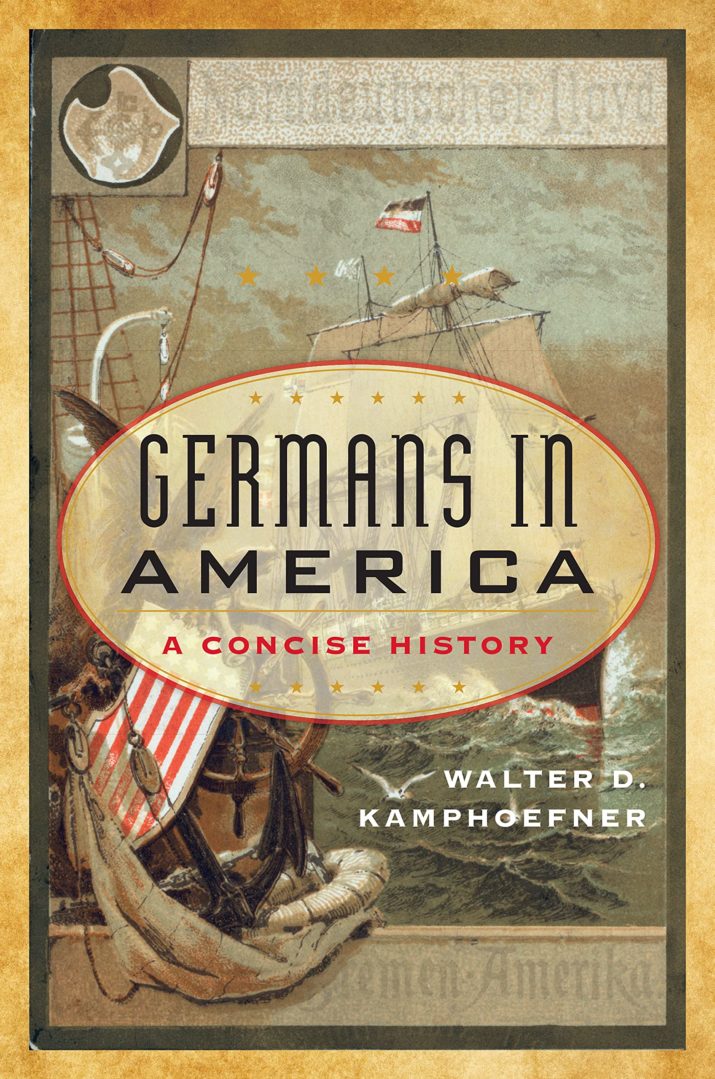

While Germans made up the largest non-English speaking ethnic group in the United States during the peak of European immigration between the early nineteenth and twentieth centuries, the visible remnants of the immigrant world they built are sparse: a few historical traces in place names and a large population of primarily white Americans with nominal German ancestry. Those third or fourth generation descendants may still bear German-sounding last names but they have long since assimilated so thoroughly into mainstream American society that their culture differs only slightly from that of white Americans of English, Irish, or Italian ancestry. Nevertheless, German-American migrants have left many other, less obvious traces on the country, ranging from religion to primary education to myriad other social, economic, political, and religious innovations, which thereafter became “American.” These innovations have remained influential in American society, even if most Americans are not aware of their German origins.
German-American studies is no longer a popular field of historical inquiry. Some new research is still conducted, but at a much lower frequency than in the later decades of the twentieth century. What new insights scholars present, however, are still valuable contributions. This more recent scholarship is what Walter Kamphoefner presents in a work of agile synthesis that spans a wide range of time and space, crossing three centuries and two continents. Germans in America: A Concise History is, as the subtitle indicates, a succinct work. As such, it is one of impressive breadth. This book is intended to be accessible to readers without much background knowledge of German America and maintains a focus on the voice of the German immigrants themselves. Kamphoefner does this by weaving a dense fabric of first-hand accounts gathered from newspapers, booster literature, and personal correspondence, among other sources, which make the German immigration experience immediately palpable. Beyond detailing the simple immediate circumstances of immigration, Kamphoefner also addresses the expansive German-American world these immigrants built in America from 1683 until the early twentieth century. The individual chapters are connected by a number of questions that provide the central inquiry of the work:
- How did German-speaking immigrants relate to the American mainstream?
- How long and how successfully did they preserve their ethnic identities, including their native tongue?
- What constituted this ethnic identity for German-Americans themselves and for others, in positive, negative, and neutral ways?
Although the book includes a background chapter on early German immigration and a concluding chapter on German-America in the twentieth century, its chronological focus constitutes the author’s own interpretation of a “long” nineteenth century, beginning in the aftermath of the Napoleonic Wars in 1816 and ending with the entry of the United States into WWI in 1917. The year 1816 did not only mark the end of decades of inter-European warfare; it was also the “year without summer,” a period of abnormally cold temperatures and poor harvests caused by the volcanic eruption of Mount Tambora in Indonesia. These temperatures led to a massive outmigration from German-speaking Europe to America. The end of Kamphoefner’s nineteenth century is widely regarded as the time German America ended as a distinct entity due to the combined forces of the wartime crescendo of anti-German sentiments, which had been festering in the United States since the turn of the century, and the ongoing assimilation of German-Americans into the American mainstream. While the book’s chapters are arranged in broad chronological order, they focus on different themes: education, religion, women’s lives, international and intercommunal economics, and the German public sphere. As much as the book coheres as a single volume, each chapter can also stand on its own as essentially a long essay on a specific topic rather than on a restrictive period. This approach allows for a specific topic to be covered both holistically and in depth. Still, Kamphoefner delivers a thick and rich picture of German-American life principally, though not exclusively, in the nineteenth century.
In the initial chapter, Kamphoefner delivers an analysis of German America in the time before the nineteenth century, from the arrival of the Krefeld Mennonites on October 6, 1683 to the aftermath of the American Revolution. Here, he is primarily interested in the continuities and discontinuities between the German America of the seventeenth, eighteenth, and nineteenth centuries. The following chapters cover the heyday of German America primarily in the nineteenth century. Through it all, Kamphoefner examines the push-and-pull factors that caused Germans to emigrate to the United States. Some of his most important insights come in his close reading of immigrant letters from both America and Germany, which reflect on the reasons Germans left their home villages, the conditions they encountered upon arrival in their new settlements and towns, and prospects for future migration. Over the roughly three centuries the book covers, Germany transformed from loose networks of states to two unified empires, to a series of republics, each new political system encompassing different national borders. Therefore, understanding the social and political conditions the immigrants came from are essential to understanding how they experienced the United States, which was also regionally stratified and politically in flux. While pre-revolutionary German immigrants came to the United States because on religious persecution in their homeland, later generations of immigrants had different reasons for coming. Many sought to escape stifling inheritance laws or political prosecution. However, Kamphoefner indicates that the overwhelming majority of German immigrants were not uprooted but rather transplanted. Many came to America to join families and friends who had gone before them, and, in doing so, replicated social structures and networks from the old country in the new.
Kamphoefner confirms this primacy of reconciliation when he weighs in on the various immigration societies that also sought to encourage German settlement. A prominent example is the Adelsverein, an immigration society founded by a group of noblemen and aristocrats who sought to solve the issues of peasant landlessness and unemployment in Germany by recruiting many of these young men for settlement in Texas. The initial effort was by all accounts a massive failure. The noblemen failed to attract as many settlers as they had hoped they could, and their society quickly ran out of money. Nevertheless, after the society had failed, the few Germans who had successfully settled in Texas Hill Country proved effective in attracting settlers through personal connections: family members and former neighbors wrote back home and attracted a subsequent wave of immigration, with this process repeating several times. More Germans immigrated to Texas after the Adelsverein ceased its operations than did so under the society’s banner. Both diary entries and excerpts from immigrant letters underline how much the contemporary settlers thought the Adelsverein had been a failure. This immigration society, with its booster literature praising the prospect of settling in Texas and top-down planning, simply could not connect people as effectively as the organically formed familial and communal networks that ultimately drew new migrants to the settlement. These personal connections were indeed so successful that the part of Texas in which these immigrants settled still bears the visible traces of German America in place names, institutions, and people’s surnames. That region is also one of the few places in the United States where—at least until the very recent past—German has remained actively spoken.
The way in which the book covers the Germans’ role in the American Civil War is particularly effective, as the author successfully addresses various misconceptions about the immigrants’ role in that war, about which much has been written. Some historians have been overly positive, while others have engaged in too much overcorrection, in effect portraying the German element during that time as more cowardly and anti-Union than the historical record actually indicates. Kamphoefner sets the various records straight. He shows that the sheer scope of the German element reflected a variety of ideological affiliations and wartime experiences. Some of these experiences were admirable, such as the genuinely awe-inspiring activities of the 9th Ohio and the 82nd Illinois infantry regiments and of the group of Germans in St. Louis who kept Missouri in the Union. Other experiences involved less admirable Union generals, such as Franz Sigel who was overwhelmed by his responsibilities, and those regiments that simply collapsed on the battlefield. The book also addresses German Texans who fought for the Union, as well as the few German-Americans who sided with the Confederacy. Kamphoefner’s wide and evenhanded approach to these matters offers a laudable corrective to the existing, often myopic, historiography.
What the stories in Germans in America show is that the German-Americans, as any other immigrant community, cannot simply be pigeon-holed based on their ancestral origin or certain customs they brought to their new homeland. Kamphoefner extends this point further as he brings the narrative to its twentieth century conclusion. He addresses German-American affinities with both Germany and the United States during WWI at a time of particular tension. By this point in time and under domestic pressure to show unfailing patriotism for their adopted country (even if that adoption had taken place generations earlier), German-Americans essentially disappeared into the American mainstream, with a few minor resurgences that never had much influence before and after WWII. Kamphoefner, however, goes further than most previous historians of German America insofar as he acknowledges that German-American life did not entirely cease with WWI and draws attention to the utter lack of research on the topic in the latter three-quarters of the twentieth century. By that time, the community of German-Americans was no longer as active and diverse as it had been during the nineteenth century, but it was still much richer than the existing historiography suggests.
Kamphoefner is able to convincingly offer these types of correctives not only through his wide reading of contemporary scholarship but also his use of letters and other documents written by the German immigrants and settlers themselves. Indeed, one of the best qualities of this book is the way in which it balances the secondary source syncretism with the voices of the historical communities under study. Kamphoefner’s sources range widely across places of origin, classes, occupations, genders, and political persuasions. What comes across is a picture that truly reflects the wide variety of people that shared a German-American identity and the many ways in which they adapted to and navigated in their adopted country through three centuries of turbulence.
Sebastian Wüpper is a German-American historian with degrees from the Free University of Berlin and Loyola University Chicago. He works as a post-doctoral scholar and conducts research and writing for textbooks and radio programs in Grand Rapids, Michigan. His current projects are a history of German-American immigration in the post-World War II era and a documentation project on child sexual abuse at Jesuit universities.
Germans in America: A Concise History
By Walter D. Kamphoefner
Publisher: Rowman & Littlefield
Hardcover / 275 pages / 2021
ISBN 9781442264977
Published on January 17, 2023




